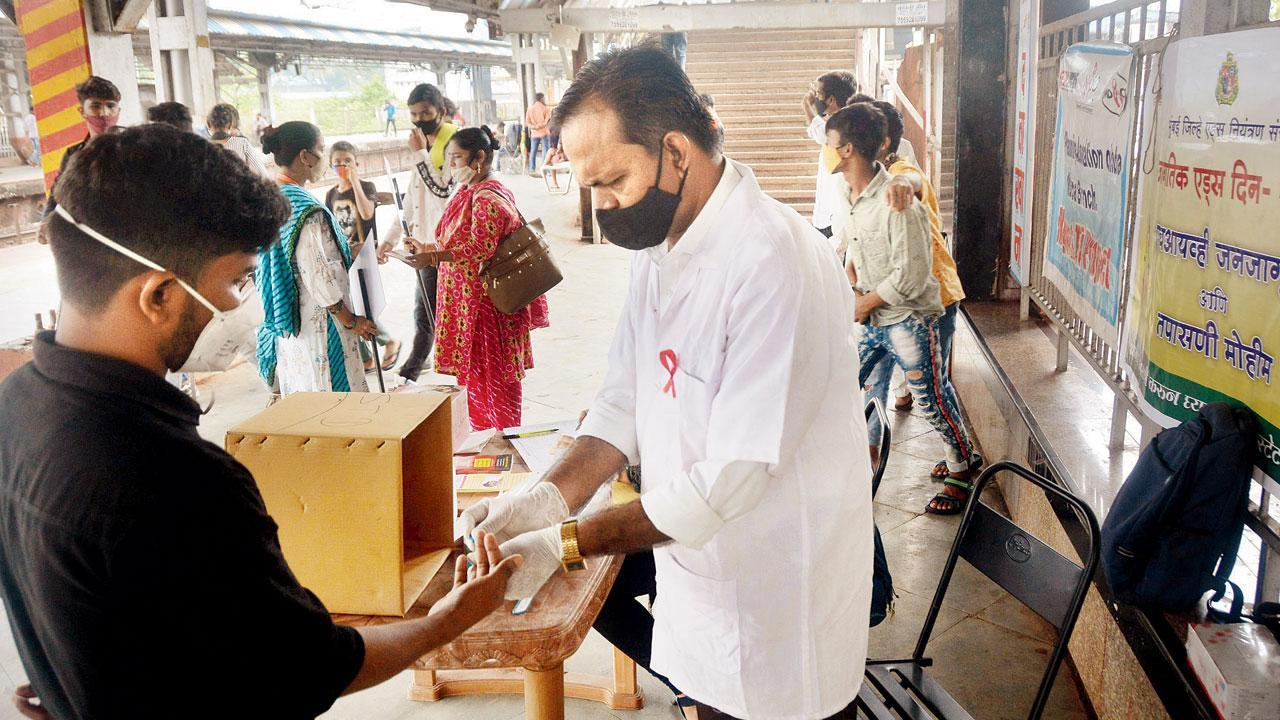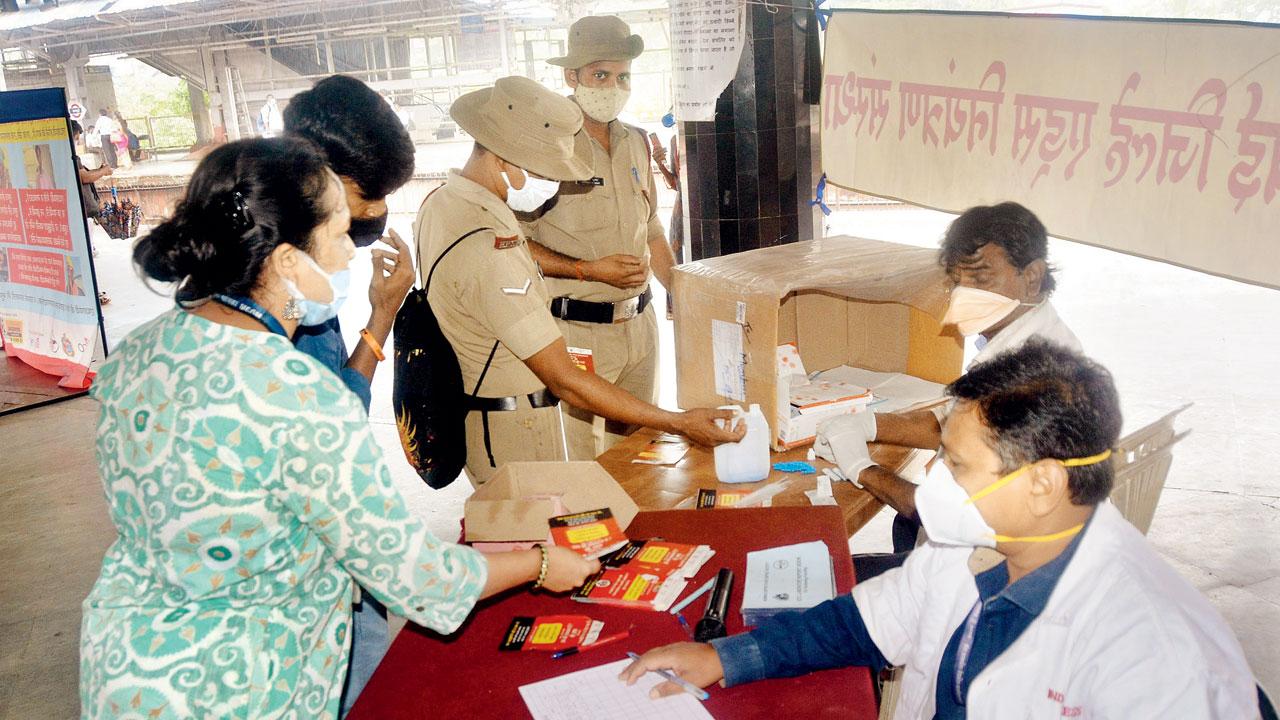Severely hit amid pandemic, testing has bounced back to reach 4.5 lakh people but this is not enough for densely populated Mumbai

An official from the Mumbai District AIDS Control Society estimated city’s actual HIV-positive individuals to be 65,000. Pic/Sayyed Sameer Abedi
Mumbai has 39,922 people living with HIV-AIDS (PLHIV), most of whom rely on Mumbai’s 20-odd Antiretroviral Therapy (ART) centres to manage the disease. However, the number of PLHIV has been more or less stagnant for the last few years, prompting experts to call for caution while interpreting this data. Experts say even by conservative estimates, at least 25,000 individuals are missing out on the treatment.
The Mumbai District AIDS Control Society (MDACS) runs 50 standalone Integrated Counselling and Testing Centres (ICTC) in the city, along with frequent outreach testing programmes at the community level. However, a combination of data from these centres and private facilities shows a stagnation in the testing rate. “The more you test, the more accurate the picture,” said HIV-TB survivor and health activist Ganesh Acharya, who has been working with health officials, NGOs, and other patients for almost two decades to secure better treatment and care for PLHIV.

People who test positive for HIV are referred to the nearest of the 20 ARTs for free-of-cost treatment in the city. Pic/Sayyed Sameer Abedi
In 2019-20, 4,75,540 people were tested in the city, and 4,473 were diagnosed with HIV. Testing was reduced as the pandemic hit. “A lot of our manpower was diverted to controlling COVID-19 then,” said MDACS assistant project director, Dr Vijay Karanjikar. Testing numbers dropped by half to 2,36,392 in 2020-21, with 1,927 new HIV patients brought under the ambit of free-of-cost medicines. These HIV medicines would otherwise cost at least R5,000 every month.
In 2022-23, 4,55,779 people were tested and 3,116 connected to ART centres. In 2023-24, till October, 2,64,277 people have been tested so far and 1,803 positive patients have been connected to ART centres. In 2023-24, among those who were newly diagnosed, 75 per cent were in the group of 15-49 years while 31 per cent were women.
Transmission potential
While testing figures have again risen to about 4.5 lakh (in 2022-23), Acharya noted that it is not enough for a highly populated city like Mumbai, and estimated that there are at least 80,000 individuals with AIDS in the city. “Diagnosing more individuals will make sure HIV patients are put on life-saving treatment at the earliest and transmission is controlled,” he said.
In 2022-23, viral load testing was conducted among 35,106 PLHIVs receiving treatment. Out of these, 34,094 patients (97.1 per cent) were found to be virally suppressed, reducing the likelihood of transmitting the disease to others.
The discrepancy in data and the ground reality were acknowledged by MDACS’s Dr Karanjikar, too. He suggested the city has a total of 65,000 PLHIV. “We are not denying undiagnosed cases. All we are saying is that these are the number of people that we have been able to diagnose. Besides, private practitioners and doctors will also cover a large number of people, and not all provide us with prompt data,” he said.
Acharya also noted that the achievements of MDACS cannot be discounted despite its limitations. “MDACS has managed to make it a democratic space with an inclusive approach by consultation and outreach from within the HIV community,” he said. “Politically and financially, it needs to be stronger.”
Issues to address
Health officials acknowledged certain challenges that need further work. For instance, not all who were diagnosed at ICTCs are covered by ART centres. Since 2019, less than 95 per cent have been linked to ART centres. “It is a loss in the follow-up rate which cannot be more than five per cent,” Acharya said.
This was also noted by MDACS. “To end the AIDS epidemic by 2030, there needs to be a 95-95-95 treatment goal by 2025, which means 95 per cent of people living with HIV must know their HIV status, 95 per cent of people who know their status should be receiving treatment, and 95 per cent of people on HIV treatment need to have a suppressed viral load,” its statement ahead of World AIDS Day reads.
On the other hand, excluding Mumbai, Maharashtra has a total of 2,26,025 PLHIV having ART as regular treatment; 18,321 (8.1 per cent) have dropped out of the treatment and are untraceable.
‘Consider city’s context’
Dr Srikala Acharya, former MDACS project director and part of KEM Hospital’s community health department, said the city’s numbers need to be looked at in a context. “Mumbai has been able to control loss-to-follow with our health workers visiting patients’ houses to ensure they are linked to ART centres continuously. Earlier, the gap was wider as only 85 per cent of those diagnosed would make it to treatment centres,” she said.
There are multiple reasons behind positive patients’ linkage to treatment centres being less than 95 per cent. “Often, deaths occur even before patients are linked to treatment centres due to other infections like TB,” Dr Srikala said, adding that the other is migration. At the time of Census 2011, the Urban Agglomeration of Mumbai—which includes city, suburbs, and Thane—had a population of 2.35 crore, of which 1.01 crore (43.02 per cent) were migrants.
It is human nature that in the face of calamity, one runs home out of fear, she said. “It is a life-changing diagnosis, and sometimes people are often untraceable once their result is HIV positive,” Dr Srikala noted.
While the AIDS control programme successfully brings high-risk individuals—transgenders, males who have sex with males, injecting drug users, and sex workers— under its ambit, it is still falling behind in bringing young adults and adolescents into its fold. The old strategies of HIV control are proving ineffective in the new generation even as MDACS routinely holds outreach programmes in schools and colleges. Despite multiple requests, MDACS could not provide data on AIDS mortality.
 Subscribe today by clicking the link and stay updated with the latest news!" Click here!
Subscribe today by clicking the link and stay updated with the latest news!" Click here!










